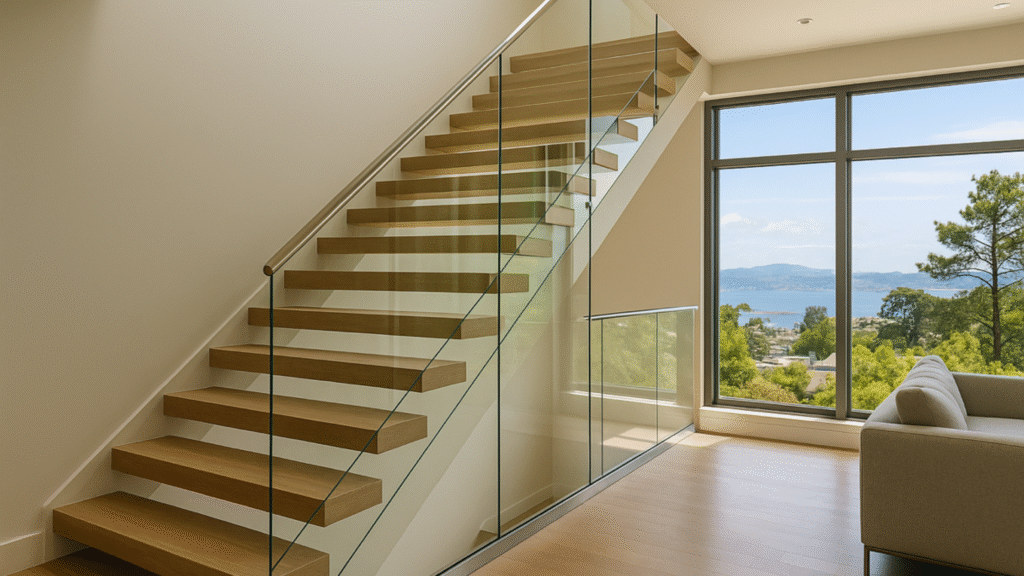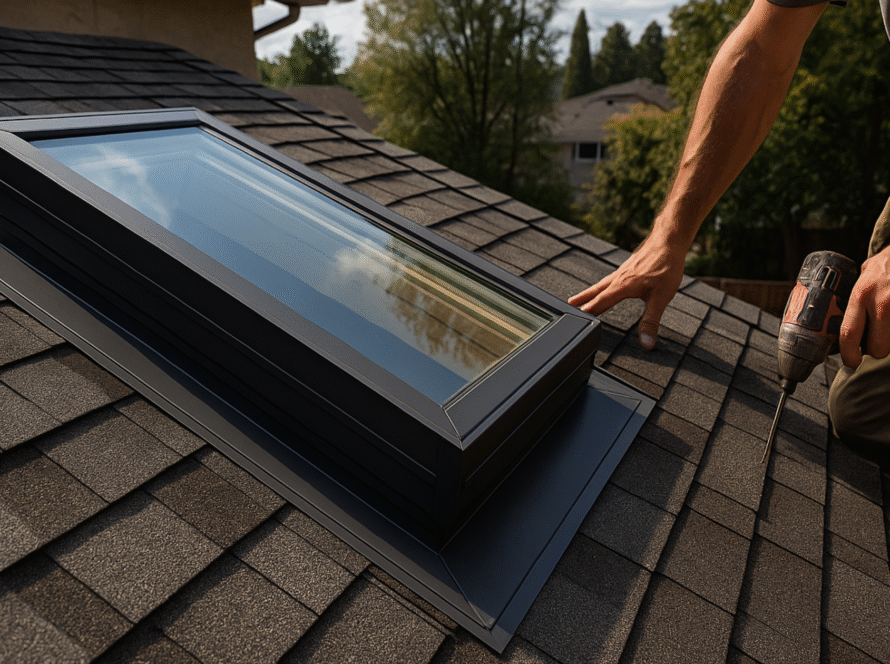
Glass railings transform traditional staircases into stunning architectural features. Learn how stairs with glass railing can open up your space, increase natural light flow, and add contemporary elegance to Bay Area homes.
Why Homeowners Choose Glass Stair Railings
Stairs with glass railing have become one of the most requested features in modern home design across the Bay Area. These sleek railing systems replace traditional wood or metal balusters with transparent glass panels that preserve sightlines while providing essential safety. The result creates an open, airy feeling that makes spaces appear larger and more connected.
Bay Area homes particularly benefit from glass stair railings, as they maximize the natural light that filters into residential spaces. With many properties featuring scenic views of the hills, bay, or cityscape, glass panels keep these vistas visible from multiple levels of the home.
Creating Open Spaces with Glass Panels
Traditional stair railings with vertical balusters create visual barriers that divide spaces and block light. A glass railing system eliminates these obstructions. When sunlight enters through windows, it flows freely through the transparent panels, illuminating adjacent rooms and hallways.
This open concept works exceptionally well in contemporary Bay Area architecture, where connecting indoor and outdoor spaces matters. Glass panels maintain the clean lines that define modern aesthetics while meeting all safety code requirements for residential staircases.
Design Options for Glass Stair Railing Systems
The market offers several distinct styles of glass railing systems, each with different aesthetic qualities and installation methods. Understanding these options helps homeowners select the best match for their design vision and budget.
Frameless Glass Railings represent the most minimal approach. These systems use thick tempered glass panels with hidden hardware, creating an almost invisible barrier. The glass appears to float beside the staircase with minimal metal components visible. This ultra-modern look commands premium pricing but delivers unmatched visual clarity.
Framed Glass Railings feature stainless steel or aluminum posts that support thinner glass panels. The metal framework adds a decorative element while reducing material costs. These systems work well with both contemporary and transitional design styles.
Post-Mounted Systems attach glass panels between evenly spaced posts using clamps or channels. This traditional mounting method provides strong support and suits a wide range of architectural styles. The visible hardware becomes part of the design aesthetic.
Base Rail Systems secure glass panels into a bottom channel, eliminating the need for posts in some applications. This clean installation method works particularly well for floating staircases, where maintaining open space beneath the treads is important.
Material Selection for Stair Railing Components
Glass quality and hardware choices significantly impact both the appearance and durability of the railing system. Professional installations use materials specifically engineered for safety and longevity.
Glass Panel Options
Tempered Glass undergoes heat treatment that makes it four to five times stronger than standard glass. If broken, it shatters into small, relatively harmless pieces rather than dangerous shards. Most residential stair railings use tempered glass panels measuring 3/8 inch or 1/2 inch thick. This remains the most cost-effective choice for interior applications.
Laminated Glass bonds two glass sheets together with a protective interlayer. When broken, the pieces adhere to the interlayer rather than falling free. This added safety feature makes laminated glass ideal for homes with young children or for installations where falling glass poses particular concerns. Laminated options cost more but provide enhanced protection.
Low-Iron Glass eliminates the greenish tint found in standard glass, producing crystal-clear transparency. This premium option showcases the purest aesthetic but adds to the project budget.
Hardware and Mounting Systems
The metal components that support glass panels are available in several finishes. Stainless steel offers exceptional durability and a modern aesthetic that complements glass beautifully. It resists corrosion, making it suitable for homes near the coast where salt air accelerates metal degradation.
Aluminum hardware provides a lightweight alternative with good corrosion resistance at a lower price point. Powder-coated finishes in black, bronze, or custom colors allow coordination with other home fixtures.
Wood top rails, combined with glass panels, add warmth to the modern aesthetic. Oak, walnut, or maple handrails provide a comfortable grip while creating visual interest against the transparent glass.
Installation Considerations and Building Codes
Professional installation ensures glass stair railings meet safety requirements and perform reliably for decades. Bay Area building codes specify minimum height requirements, load capacity, and glass specifications that installations must satisfy.
Standard residential stair railings measure 36 inches high, though some designs extend to 42 inches. The glass panels must withstand specific horizontal loads without deflecting excessively. Engineers calculate these loads based on panel dimensions, glass thickness, and support spacing.
Mounting methods vary depending on stair construction. Wood stairs typically allow direct mounting to treads or stringers. Concrete or steel stairs may require specialized anchors or embedded mounting plates. Each installation method requires specific hardware designed for that application.
Ready to transform your staircase with modern glass railings? Explore professional window replacement services that can design and install custom glass systems for your home.
Cost Factors for Stairs with Glass Railing
The investment in glass stair railings varies based on several factors. Understanding these cost drivers helps homeowners budget appropriately for their project.
Material selection accounts for the greatest price variation. Basic framed systems with tempered glass and aluminum hardware start around $150 per linear foot installed. Premium frameless systems using thick, low-iron glass and stainless steel components can cost $600 per linear foot or more.
Installation complexity affects labor costs. Straight staircases with standard dimensions install more quickly than curved or spiral stairs that require custom glass panels. Difficult access to upper floors or challenging mounting surfaces increases installation time and expense.
Most residential staircase projects with glass railings range from $4,000 to $15,000. Larger homes with multiple stair runs or premium materials can exceed $20,000. This investment typically returns 60% to 75% of its cost when selling a home, particularly in markets where modern design features command premium prices.
Maintenance and Long-Term Performance
Glass stair railings require minimal maintenance compared to traditional wood railings, which require periodic refinishing. Regular cleaning with standard glass cleaner keeps panels transparent and attractive. Most installations need cleaning every 2 to 4 weeks, depending on household traffic and whether young children touch the glass frequently.
The hardware components need occasional inspection to ensure mounting bolts remain tight. Coastal properties should rinse exterior railings periodically to remove salt deposits that could affect metal finishes over time.
Quality installations using properly tempered glass and corrosion-resistant hardware easily last 20 years or more with basic maintenance. This durability makes glass railings a practical long-term choice for Bay Area homes.
Combining Glass Railings with Other Home Features
Glass stair railings coordinate beautifully with other modern home elements. The transparent panels work particularly well in homes emphasizing natural light and open floor plans. Homeowners often integrate glass railings throughout their properties, using them on both interior stairs and exterior balconies to create a consistent design language.
Multi-story homes with open floor plans use glass railings on both stairs and upper-level walkways to maintain visual flow between levels. This creates seamless transitions while preserving sightlines and light transmission throughout the home.
Properties designed in a contemporary style benefit from the clean lines and minimal visual weight that glass railing systems offer. Hardware finishes can coordinate with other fixtures, such as door handles, light fixtures, and cabinet pulls, to create a cohesive interior design.
Making the Right Choice for Your Home
Stairs with glass railings offer a proven way to modernize Bay Area homes, improve functionality, and add value. The transparent panels eliminate visual barriers, maximize natural light distribution, and create the open, connected spaces that contemporary homeowners prefer.
Consider your home’s architectural style, your budget, and how the glass railing system will integrate with existing design elements. Professional glass installation specialists can provide accurate project estimates and design guidance specific to your staircase configuration.
The investment in quality materials and proper installation delivers decades of beautiful, low-maintenance performance. For Bay Area homeowners seeking to elevate their interior design while maintaining practical functionality, glass stair railings represent an excellent choice that balances aesthetics with long-term value.
How will transforming your staircase with a modern glass railing system change the way you experience your home’s interior spaces?
Since 1987, Insight Glass has provided top-quality windows & patio doors in the Bay Area.
Call 707-746-6571 for Expert Installation!
CONTACT US TO GET A FREE ESTIMATE!


